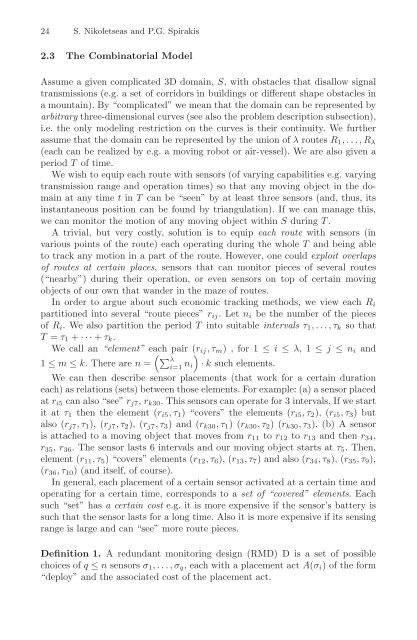Lecture Notes in Computer Science 4837
Lecture Notes in Computer Science 4837
Lecture Notes in Computer Science 4837
You also want an ePaper? Increase the reach of your titles
YUMPU automatically turns print PDFs into web optimized ePapers that Google loves.
24 S. Nikoletseas and P.G. Spirakis<br />
2.3 The Comb<strong>in</strong>atorial Model<br />
Assume a given complicated 3D doma<strong>in</strong>, S, with obstacles that disallow signal<br />
transmissions (e.g. a set of corridors <strong>in</strong> build<strong>in</strong>gs or different shape obstacles <strong>in</strong><br />
a mounta<strong>in</strong>). By “complicated” we mean that the doma<strong>in</strong> can be represented by<br />
arbitrary three-dimensional curves (see also the problem description subsection),<br />
i.e. the only model<strong>in</strong>g restriction on the curves is their cont<strong>in</strong>uity. We further<br />
assume that the doma<strong>in</strong> can be represented by the union of λ routes R1,...,Rλ<br />
(each can be realized by e.g. a mov<strong>in</strong>g robot or air-vessel). We are also given a<br />
period T of time.<br />
We wish to equip each route with sensors (of vary<strong>in</strong>g capabilities e.g. vary<strong>in</strong>g<br />
transmission range and operation times) so that any mov<strong>in</strong>g object <strong>in</strong> the doma<strong>in</strong><br />
at any time t <strong>in</strong> T can be “seen” by at least three sensors (and, thus, its<br />
<strong>in</strong>stantaneous position can be found by triangulation). If we can manage this,<br />
we can monitor the motion of any mov<strong>in</strong>g object with<strong>in</strong> S dur<strong>in</strong>g T .<br />
A trivial, but very costly, solution is to equip each route with sensors (<strong>in</strong><br />
various po<strong>in</strong>ts of the route) each operat<strong>in</strong>g dur<strong>in</strong>g the whole T and be<strong>in</strong>g able<br />
to track any motion <strong>in</strong> a part of the route. However, one could exploit overlaps<br />
of routes at certa<strong>in</strong> places, sensors that can monitor pieces of several routes<br />
(“nearby”) dur<strong>in</strong>g their operation, or even sensors on top of certa<strong>in</strong> mov<strong>in</strong>g<br />
objects of our own that wander <strong>in</strong> the maze of routes.<br />
In order to argue about such economic track<strong>in</strong>g methods, we view each Ri<br />
partitioned <strong>in</strong>to several “route pieces” rij. Letni be the number of the pieces<br />
of Ri. We also partition the period T <strong>in</strong>to suitable <strong>in</strong>tervals τ1,...,τk so that<br />
T = τ1 + ···+ τk.<br />
We call an “element” each pair (rij,τm) ,for1≤ i ≤ λ, 1≤ j ≤ ni �<br />
and<br />
1 ≤ m ≤ k. Therearen =<br />
· k such elements.<br />
��λ i=1 ni<br />
We can then describe sensor placements (that work for a certa<strong>in</strong> duration<br />
each) as relations (sets) between those elements. For example: (a) a sensor placed<br />
at ri5 can also “see” rj7, rk30. This sensors can operate for 3 <strong>in</strong>tervals. If we start<br />
it at τ1 then the element (ri5,τ1) “covers” the elements (ri5,τ2), (ri5,τ3) but<br />
also (rj7,τ1), (rj7,τ2), (rj7,τ3) and(rk30,τ1) (rk30,τ2) (rk30,τ3). (b) A sensor<br />
is attached to a mov<strong>in</strong>g object that moves from r11 to r12 to r13 and then r34,<br />
r35, r36. The sensor lasts 6 <strong>in</strong>tervals and our mov<strong>in</strong>g object starts at τ5. Then,<br />
element (r11,τ5) “covers”elements(r12,τ6), (r13,τ7) andalso(r34,τ8), (r35,τ9),<br />
(r36,τ10) (and itself, of course).<br />
In general, each placement of a certa<strong>in</strong> sensor activated at a certa<strong>in</strong> time and<br />
operat<strong>in</strong>g for a certa<strong>in</strong> time, corresponds to a set of “covered” elements. Each<br />
such “set” has acerta<strong>in</strong>coste.g. it is more expensive if the sensor’s battery is<br />
such that the sensor lasts for a long time. Also it is more expensive if its sens<strong>in</strong>g<br />
range is large and can “see” more route pieces.<br />
Def<strong>in</strong>ition 1. A redundant monitor<strong>in</strong>g design (RMD) D is a set of possible<br />
choices of q ≤ n sensors σ1,...,σq, each with a placement act A(σi) oftheform<br />
“deploy” and the associated cost of the placement act.
















